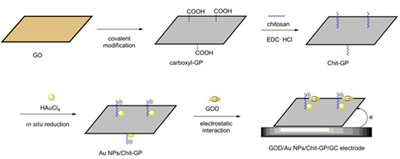[1] Wang, Y.; Li, Z. H.; Li, J. H.; Lin, Y. H. Trends Biotechnol. 2011, 29, 205.
[2] Liu, Y.; Wang, M.; Zhao, F.; Xu, Z.; Dong, S. J. Biosens. Bioelectron. 2005, 21, 984.
[3] Zeng, Q.; Cheng, J. S.; Tang, L. H.; Liu, X. F.; Liu, Y. Z.; Li, J. H.; Jiang, J. H. Adv. Funct. Mater. 2010, 20, 3366.
[4] Zhang, L.; Zhang, Q.; Li, J. H. Adv. Funct. Mater. 2007, 17, 1958.
[5] Zhang, Y.; Zheng, J. b. Acta Chim. Sinica 2011, 69, 1903. (张亚, 郑建斌, 化学学报, 2011, 69, 1903.)
[6] Wang, Y.; Li, Z.; Hu, D.; Lin, C. T.; Li, J. H.; Lin, Y. H. J. Am. Chem. Soc. 2010, 132, 9274.
[7] Tang, L. H.; Wang, Y.; Li, Y. M.; Feng, H. B.; Lu, J.; Li, J. H. Adv. Funct. Mater. 2009, 19, 782.
[8] Wang, Y.; Shao, Y. Y.; Dean W. M.; Lin, Y. H.; Li, J. H. ACS Nano 2010, 4, 1790.
[9] Liu, S.; Tian, J. Q.; Luo, Y. L.; Lu, W. B.; Sun, X. P. Biosens. Bioelectron. 2011, 26, 4491.
[10] Jiang, H. J.; Zhao, Y.; Yang, H.; Aking, D. L. Mater. Chem. Phys. 2009, 114, 879.
[11] Chen, D.; Tang, L. H.; Li, J. H. Chem. Soc. Rev. 2010, 39, 3157.
[12] Zhang, H.; Lv, X. J.; Li, Y. M.; Wang, Y.; Li, J. H. ACS Nano 2009, 4, 380.
[13] Jin, Y.; Chen, H.-Y.; Chen, M.-H.; Liu, N.; Li, Q.-W. Acta Phys.-Chim. Sinica 2012, 28, 609. (靳瑜, 陈宏源, 陈名海, 刘宁, 李清文, 物理化学学报, 2012, 28, 609.)
[14] Wu, J. F.; Xu, M. Q.; Zhao, G. C. Electrochem. Commun. 2010, 12, 175.
[15] Swoboda, B. E. P.; Massey, V. J. Biol. Chem. 1965, 240, 2209.
[16] Leskovac, V.; Trivić, S.; Wohlfahrt, G.; Kandrac, J.; Pericin, D. Int. J. Biochem. Cell B 2005, 37, 731.
[17] Dupont, J.; Spencer, J. Angew. Chem. Int. Ed. 2004, 43, 5296.
[18] Shan, C.; Yang, H.; Song, J.; Han, D.; Ivaska, A.; Niu, L. Anal. Chem. 2009, 81, 2378.
[19] Liu, Q.; Lu, X. B.; Li, J.; Yao, X.; Li, J. H. Biosens. Bioelectron. 2007, 22, 3203.
[20] Xiao, C.; Chu, X.; Wu, B.; Pang, H.; Zhang, X.; Chen, J. Talanta 2010, 80, 1719.
[21] Liu, S. Q.; Ju, H. X. Biosens. Bioelectron. 2003, 19, 177.
[22] Kang, X. H.; Wang, J.; Wu, H.; Aksay, I. A.; Liu, J.; Lin, Y. H. Biosens. Bioelectron. 2009, 25, 901.
[23] Hummers, W. S.; Offeman, R. E. J. Am. Chem. Soc. 1958, 80, 1339. Lomeda, J. R.; Doyle, C. D.; Kosynkin, D. V.; Hwang, W. F.; Tour, J. M. J. Am. Chem. Soc. 2008, 130, 16201. |
